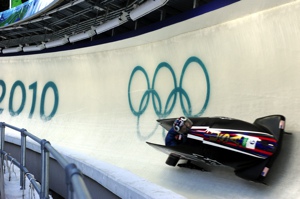Bobsleighing Rules

Bobsleighing, also known as 'bobsledding', is a high-speed winter racing sport where teams (of two or four, depending on the type of event) hop aboard sleds and travel down curved ice tracks. Each team relies on gravity to move at the fastest possible pace, with pilots pulling on rings to steer the sleds and improve their track position. The name bobsleigh comes from the “bobbing” motion drivers used to make when they were attempting to get their sleighs going at the beginning of a race.
It will come as no surprise to learn that the origins of bobsleigh can be traced back to Switzerland. Winter sports are Switzlerland's speciality and citizens of the snowy alpine lands helped to popularise bobsleighing as long ago as the 1860s. Starting off as a recreational activity, this now-famous winter sport morphed into a competitive game over the subsequent decades, appearing at the debut Olympic games in 1924.
When bobsleighing began, participators used wooden sleds to slide their way down the tracks, although these were eventually replaced by steel-based vehicles as the sport accrued wider attention and recognition. There are now both two-man and four-man tournaments held in bobsleigh at the Olympics, with events available for both men and women.
Expectedly, Switzerland are one of the most successful nations in Olympic bobsledding, with Germany and USA also picking up a wide variety of medals in the sport.
Object of the Game
Bobsleighing is a racing sport – and the first team to reach the finish line at the end of the race is crowned the victor. Bobsleigh vehicles will have two or four athletes inside depending on the type of event, and the teams’ crews push the vehicles off from a standing start to begin their movement down the track.
Players & Equipment
Bobsleigh is a team event with two or four participants representing a side. The bobsleigh vehicle itself is the main piece of equipment, although there are other factors to consider.
- Bobsleigh Vehicles: The vehicles in bobsleigh are far more advanced today than they once were. Considerable effort has gone into designing sleds that are aerodynamic, with various forms of light metal and steel used as materials.
- Crews: Because bobsleighing is a sport dictated by gravity, every team needs to be pushed into action by crew members – who literally get behind the bobsleigh vehicle and force the vehicle onto the track to begin the momentum. Every person in a bobsleigh team has a specific role to play, be it a pilot, a brakeman or a pusher.
- Steering Equipment: Every bobsleigh car is fitted with two metal rings on either side that that helps the pilot to direct the vehicle. If they wish to shift the momentum of the vehicle towards the left, the pilot pulls down on the left ring and vice versa.
Scoring
Bobsleigh teams attempt to reach the finish line on their track in the fastest possible time. They do this by:
- Steering: This is an action performed by the pilot, and needs to be implemented carefully and subtly in order to keep the bobsleigh vehicle on track at high speeds.
- Braking: This is an action performed by the brakeman, who needs to press down on a set of pads at the appropriate points on the track in order for the vehicle to take corners at optimum speed, safely.
Winning
The winner of a Bobsleigh race is the team that reaches the finish line first. At the Olympics, races are calculated over an aggregate of four separate runs known as “heats”. Race times are clocked in hundredths of seconds.
Rules of Bobsledding
Vehicle Weight:
Every bobsleigh vehicle has limitations on weight (including crew members) for an Olympic games race. The regulations are as follows:
- Four-Man Race: 630kg
- Two-Man Race: 390 kg
- Two-Woman Race: 340kg
When a race reaches its conclusion, a series of tests are conducted to ensure that athletes and vehicles have met the required regulations. If weight has been exceeded, an inquiry is launched, and the team risks being disqualified from the race (and tournament) entirely.
Athlete Safety
Every bobsleigh athlete is required to wear a set of protective clothing. This includes:
- Helmets
- Eye Goggles
- Uniforms
- Spike Shoes
- Kevlar Vests (for brakemen in order to prevent friction burns)
Bobsleigh Track
- There are strict racetrack design regulations enforced by governing bodies in bobsleigh in order minimise the risk of injuries.
- Tracks must be between 1200 – 1300 metres in length
- Tracks must accommodate vehicles so that speeds of 80-100 miles per hour can be attained in the first 250 metres.
- Tracks must be designed at an elevated level that slopes downhill, dropping from 110 metres to 125 metres.